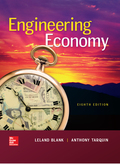
(a):
Identify the number of i* values.
(a):
Explanation of Solution
Table-1 shows the cash flow.
Table -1
| Year |
Cash flow (NC) |
| 0 | -5,000 |
| 1 | -10,100 |
| 2 | 4,500 |
| 3 | 6,500 |
| 4 | 8,500 |
| 5 | 10,500 |
| 6 | 12,500 |
Cumulative cash (CC) flow can be calculated using the following formula:
In Equation (1), the term i-1 indicates the previous time period.
Cumulative cash flow of in Year 1 can be calculated by substituting the respective values in Equation (1).
Cumulative cash flow in Year 1 is -$15,100.
Table-2 shows the net cash flow and cumulative cash flow that is obtained using Equation (1).
Table -2
| Year |
Cash flow (NC) | CC |
| 0 | -5,000 | -5,000 |
| 1 | -10,100 | -15,100 |
| 2 | 4,500 | -10,600 |
| 3 | 6,500 | -4,100 |
| 4 | 8,500 | 4,400 |
| 5 | 10,500 | 14,900 |
| 6 | 12,500 | 27,400 |
In Descartes’ rule, net cash flow is used, whereas in Norstrom’s criterion, the cumulative cash flow is used.
Norstrom’s criterion states that there is one root (i*) that is available when the cash flow starts with a negative sign and only one direction change.
Descartes’ rule states that the number of i* is equal to the number of direction change in the cash flow.
Table-2 shows that the NC cash flow has one change in direction. Thus, it would have one non-negative i* value.
Table-2 shows that the CC cash flow starts with a negative sign, and the cash flow has one change in direction. Thus, it would have one non-negative i* value.
(b):
Calculation of
(b):
Explanation of Solution
Table-1 reveals that the incremental cash flow (I) is $2,000. Time period (n) is 5 years.
Rate of return (i) can be calculated as follows:
Substitute the rate of return as 2% in the above calculation by trial-and-error method.
The calculated value is greater than the initial year net cash flow. Thus, increase the rate of return to 33.7%
Since the calculated value is nearly equal to the initial cash flow, it is confirmed that the rate of return is 33.7%.
(c):
Calculation of incremental value.
(c):
Explanation of Solution
The initial cash flow (NC0) is $5,000. The first year cash flow (NC1) is $10,100. The second year cash flow is $4,500. Rate of return (i) is 15%. Time period (n) is 5 year.
Incremental cash flow from Year 3 (I) can be calculated as follows:
Thus, the incremental value is $132.26.
Want to see more full solutions like this?
Chapter 7 Solutions
Engineering Economy

 Principles of Economics (12th Edition)EconomicsISBN:9780134078779Author:Karl E. Case, Ray C. Fair, Sharon E. OsterPublisher:PEARSON
Principles of Economics (12th Edition)EconomicsISBN:9780134078779Author:Karl E. Case, Ray C. Fair, Sharon E. OsterPublisher:PEARSON Engineering Economy (17th Edition)EconomicsISBN:9780134870069Author:William G. Sullivan, Elin M. Wicks, C. Patrick KoellingPublisher:PEARSON
Engineering Economy (17th Edition)EconomicsISBN:9780134870069Author:William G. Sullivan, Elin M. Wicks, C. Patrick KoellingPublisher:PEARSON Principles of Economics (MindTap Course List)EconomicsISBN:9781305585126Author:N. Gregory MankiwPublisher:Cengage Learning
Principles of Economics (MindTap Course List)EconomicsISBN:9781305585126Author:N. Gregory MankiwPublisher:Cengage Learning Managerial Economics: A Problem Solving ApproachEconomicsISBN:9781337106665Author:Luke M. Froeb, Brian T. McCann, Michael R. Ward, Mike ShorPublisher:Cengage Learning
Managerial Economics: A Problem Solving ApproachEconomicsISBN:9781337106665Author:Luke M. Froeb, Brian T. McCann, Michael R. Ward, Mike ShorPublisher:Cengage Learning Managerial Economics & Business Strategy (Mcgraw-...EconomicsISBN:9781259290619Author:Michael Baye, Jeff PrincePublisher:McGraw-Hill Education
Managerial Economics & Business Strategy (Mcgraw-...EconomicsISBN:9781259290619Author:Michael Baye, Jeff PrincePublisher:McGraw-Hill Education





